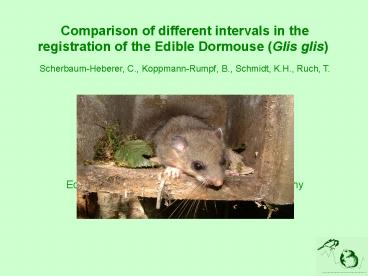PowerPointPrsentation - PowerPoint PPT Presentation
1 / 28
Title:
PowerPointPrsentation
Description:
Scherbaum-Heberer, C., Koppmann-Rumpf, B., Schmidt, K.H., Ruch, T. ... Influence of meteorological factors, social structure, chronobiology ... – PowerPoint PPT presentation
Number of Views:46
Avg rating:3.0/5.0
Title: PowerPointPrsentation
1
(No Transcript)
2
Pivotal question
3
(No Transcript)
4
Basic questions of projects Influence of
meteorological factors, social structure,
chronobiology ?daily nestbox checks
5
Comparison of different intervals daily,
weekly, every fortnight, monthly
- population size
- number of newly marked animals
- number of recaptured animals from previous year
- comparison between population estimate by JOLLY
and empirical data
6
Population estimate by JOLLY (MUEHLENBERG1993) Ba
sed on the capture-recapture method to estimate
the size of a population Pi (ai Zi/Ri ri)
ni/ri Pi population estimate on day i ni
total number of animals captured on day i ai
total number of animals released on day i (newly
marked ones and marked recaptured ones) Zi sum
of all animals marked before day i and recaptured
after day i not in the sample of day Ri sum
of all animals marked and released on day i
which were recaptured after day i Factor Zi/Ri
allows for population dynamics e.g. gains and
losses of individuals
7
- Day i day of highest MNA
- minimum number of animals known to be
alive - (PETRUSEWICZ ANRDZEJEWSKI 1962,KREBS 1966)
- data of weekly nestbox checks
8
Study area
Schluechtern (50 19 N 9 28E)
9
- Study area
- low mountain range
- altitude 250-300 m
- mixed forest consisting of oak (Quercus robur,
Q.petraea), common beech (Fagus sylvatica) and
hornbeam (Carpinus betulus)
10
- total of 185 nestboxes with 32 x 38 mm entrance
holes - two-dimensional arrays of nestboxes in 25 x 25
m grids
11
Individual marking
45621
transponder (12x2.12mm)
12
- Methods
- 2002
- weekly nestbox checks with marking of all
unmarked dormice after breeding season of
hole-breeding passerines - 2. daily nestbox checks with marking of all
unmarked individuals from July 4 th until Aug.
3rd 2002 - Daily scanning of (shut) nestboxes, opening and
marking twice a week from Aug. 4th - 2003 (and afterwards)
- Daily scanning of (shut) nestboxes opening
and marking once a week
13
Basis 375 marked individuals (from 2002) that
could be theoretically recaptured in 2003
14
(No Transcript)
15
Statistics
16
(No Transcript)
17
Statistics
18
(No Transcript)
19
Statistics
20
(No Transcript)
21
Statistics
22
(No Transcript)
23
Statistics
24
- Significant differences between...
- total number of individuals except daily vs
weekly - found individuals in except daily vs weekly
- number of missed individuals
- missed individuals in
- number of newly marked individuals except every
fortnight vs monthly - recaptures except weekly vs. every fortnight
- recaptures in except daily vs weekly, weekly vs
every fortnight
25
- Consequences
- Statements concerning for example
- population size
- death rates
- emigration/immigration
- would differ significantly using data based on
fewer checks.
26
Day of highest MNA August 8th 2003 85
individuals
JOLLY versus MNA Chi224.009 df 1 p lt
0.001 JOLLY versus daily checksChi2146.815 df
1 p lt 0.001 MNA 30,25 of total number of
individuals until Aug. 8th 37.44 of total
population size (281 individuals)
27
Using the JOLLY estimate the population would be
underestimated 7-fold. Although gains and
losses are allowed for in the JOLLY model,
empirical data shows more dynamics among the
members of the population.
28
(No Transcript)

